|
Sergio Leone's three
‘Dollar’ Westerns starring Clint Eastwood were filmed in Spain and Italy
from 1964-1966, but not released in the United States or the UK until
1967. After the success of A Fistful Of Dollars (originally
released as Per Un Pugno Di Dollari) and For A Few Dollars More
(as Per Qualche Dollaro In Più) in Italy, United
Artists saw the box-office potential of these two radically different
Westerns. The third instalment was to be the most ambitious yet, with
United Artists advancing half of the $1-million budget and negotiating for
50% of the box-office takings outside of Italy. When released in December
1966 The Good, The Bad And The Ugly (under its original title Il
Buono, Il Brutto, Il Cattivo) grossed a staggering $6.3-million in Italy alone. The three films were then prepared for
release in the USA, where they were promoted by distributor United Artists with a clever
advertising campaign centred around ‘The Man With No Name’ tag-line. In
reality Clint Eastwood does not play the same character in each film, and is
actually named in each instalment (Joe, Manco and Blondie), so the first two films were slightly
trimmed to delete all reference to his identity when first screened in English speaking markets. As was the tradition with Italian productions at
this time, all of the footage was filmed silently, with the various
foreign actors speaking dialogue in their native language. Their vocal
performances were then dubbed for the Italian release, and again with
English dialogue for US & UK distribution. A Fistful Of
Dollars (1964) debuted in the United States in January 1967, and May in the UK,
also playing for three weeks at the London Pavilion from June 8, 1967. Its sequel For A Few Dollars More
(1965) opened in
April 1967 in the US, and October in the UK. |
 |
|
Although awarded an
‘X’ certificate by the British Board of Film Censors, both films were
cut further to remove some of the more sadistic violence. The final film in the
trilogy The Good, The Bad And The Ugly (1966) premiered in the
US in December 1967, but was not seen in the UK until August 1968. In
both territories its running-time was drastically reduced from the
178-minutes of the original Italian release in 1966. The film was cut
to 161-minutes for release in the US, and 148-minutes in the UK.
The Good, The Bad And The Ugly was restored to its original length
and re-released in 2002.
|
|
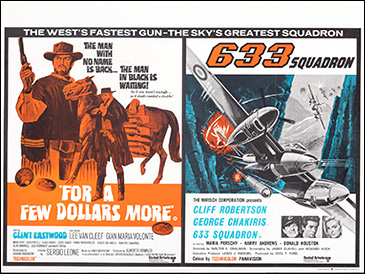 |
Initial reviews in the UK were less than kind, and it took some time for
the films to achieve the cult status that we recognise today. Penelope Mortimer
(1918-1999), Journalist, novelist and film critic for The Observer said of
For A Few Dollars More:
“...with
its howling manic music, its startling photography, its operatic
direction by Sergio Leone, it should be extremely funny, in the same
way that the Bond films, seen through a sane eye, are extremely funny.
Violence is, after all, the basis of slapstick...”
The ‘Dollar’
westerns were frequently re-issued with other United Artists
distributed films on double-bills before their sale to television.
|
|
|
One of the most
bizarre pairings was For A Few Dollars More with the WWII
action-adventure 633 Squadron (1964) which was first
seen in August 1968. United Artists then re-released
For A Few Dollars More/A Fistful Of Dollars on a double-bill which
played for two weeks at the London Pavilion from Thursday April 3, 1969
- although this time
promoted as the original “Man With No Name” classics.
|
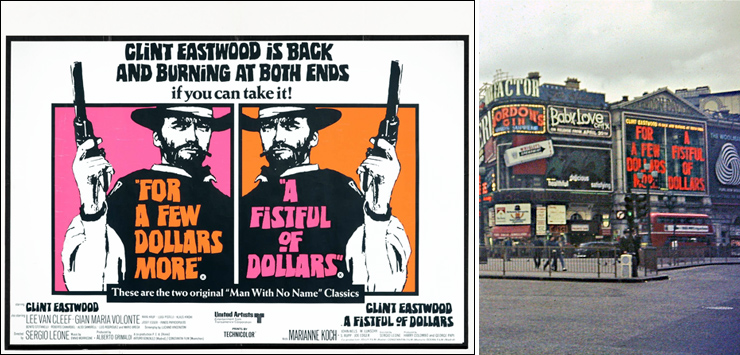 |
|
A Fistful Of Dollars
has its UK television premiere on BBC1 on Friday August 1, 1975;
followed by For A Few Dollars More on Tuesday December 30, 1975,
and
finally The Good, The Bad And The Ugly (in its shorter UK
version) on Monday April 19, 1976. All three films had their more violent
scenes trimmed further for the original TV screenings, and naturally then
shown in the standard panned-and-scanned format, which resulted in the
loss of half of the original widescreen Techniscope image. |
 |
|
After an absence of 18-months Sean Connery's most recent James Bond
film You Only Live Twice was re-released to cinemas in April 1971
on a double-bill with A Fistful Of Dollars, the first of the
so-called ‘spaghetti westerns’ starring Clint Eastwood and directed by
Sergio Leone. The double-bill also played at the London Pavilion for three
weeks from Thursday May 3, 1971. Although the James Bond films had
played with a Western as a supporting feature in the past; this new
pairing was unusual to say the least, as the Clint Eastwood westerns were
then all rated ‘X’ certificate.
In 1970 the British Board of Film Censors raised the minimum age for
admittance to ‘X’ certificate films from 16 to 18. Even under the old
regulations the combination of an ‘A’ and an ‘X’ rated film on the same
bill would significantly reduce the audience that could be admitted to
see them. Many provincial cinemas got round this loss-maker by replacing
the Clint Eastwood western with another ‘A’ certificate film in afternoon
performances in order to maximise their profits.
|
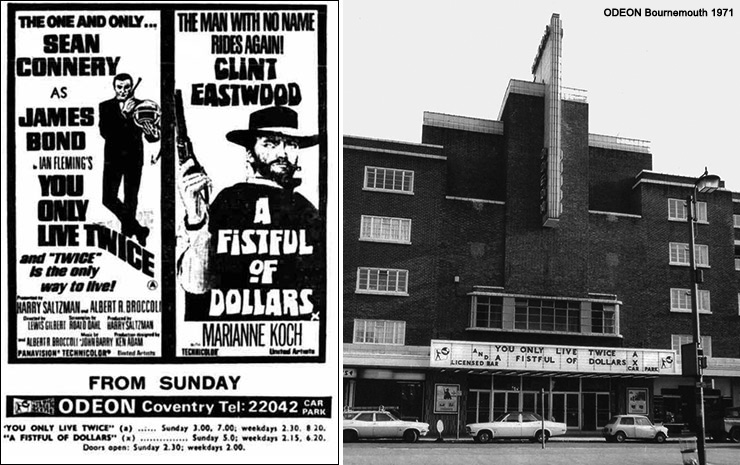 |
|
All advertising for You
Only Live Twice now stated ‘Sean Connery AS James Bond’ instead of the
‘IS’ used in the original 1967 campaign. It is
interesting to note that although the National Screen Service produced
new quad-crown posters for the James Bond/Dollar Western double-bills,
these were basically two
double-crown posters printed side-by-side but without the word ‘AND’
overlaid on the artwork. This meant that many cinemas could cut the poster
in half and use them independently, or with another film if they were playing
a different programme. Over the years these posters have been
mislabelled in auctions as original double-crowns (20 X 30 inches), when in fact they are
actually half of a quad-crown poster (30 X 40 inches when uncut). The printers credit
(in this instance Lonsdale & Bartholomew) appeared in the bottom
right-hand corner, so only one of the pair would have this. Posters created for other United Artists James Bond
double-bills have the word ‘AND’ on the artwork to link the pairing, or are genuine composites
of the two original release posters using artwork from the respective films. Now that Sean
Connery had been announced as returning as 007 in Diamonds Are Forever,
his name was now linked to the character of James Bond once again. |
|
|
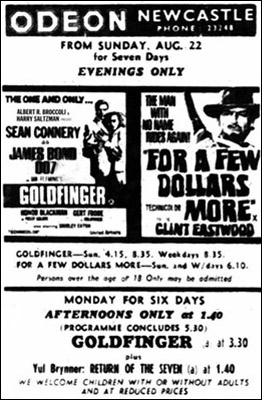 |
Encouraged by the success
of You Only Live Twice/A Fistful Of Dollars despite its
certification anomaly, United Artists then re-released Goldfinger
(which hadn't been seen in UK cinemas for two years) with For A Few
Dollars More at the London Pavilion, where they played for three weeks
from Thursday June 27, 1971. The pair also played for seven days at the Gaumont
cinema in Aberdeen from the same date, but this double-bill does not
appear to have had a wider release until August of 1971. Once again,
many cinemas [including the ODEON Newcastle pictured left] chose to pair Goldfinger with another United Artists
distributed Western (often The Magnificent Seven (1960), or its
1966 sequel Return Of The Seven) in afternoon performances so
children could attend without adults.
On Monday September 27,
1971 Goldfinger/For A Few Dollars More opened at the 841-seat Corinthian
cinema in Dublin where it played for two weeks. For A Few Dollars More
like its predecessor had a lower rating in Ireland which permitted over 15s to see the double-bill. Unusually newspaper listings stated that under 12s were allowed in if accompanied
by an adult! This implies that the version of the film screened in Ireland
had been significantly cut even further by the Irish Film Censor's Office. Both A
Fistful Of Dollars and For A Few Dollars More were re-rated by
the British Board of Film Censors in 1981 to be ‘AA’ certificate in
cinemas [admission to children of 14 years or over], and are now a
‘15’ certificate on home entertainment media in the UK, with all
previous cuts waived. |
|
|
United Artists also
planned a double-bill of Dr. No/The Good, The Bad and The Ugly
as part of ‘The One And Only...’ campaign and the National
Screen Service (the company that supplied advertising materials to UK
cinemas) advertised a quad-crown poster
also available as two
separate double-crowns for each film. A tri-fold composite press sheet
with a selection of different sized newspaper advertisement blocks was
also issued. However, there is no evidence that this pairing ever played
in a UK cinema in 1971/72. The double-bill did play in the Republic of
Ireland at the Superama Cinema in Dublin for two weeks From Friday October
22, 1971. The huge 2,000-seat cinema had previously been
called the Dublin Cinerama Theatre, and capable of playing the handful of
films made in the three-panel projection system on its huge curved screen.
Before 1965 there were no certificates for films screened in the Republic
of Ireland, with content tailored for a general audience by the Irish Film
Censor's Office. This resulted in the majority of films being subjected to
cuts. After 1965 those films aimed at an adult audience were certificated
as suitable for ‘Over 16’ or ‘Over 18’ by IFCO, but were still routinely cut, or sometimes
banned outright in Ireland. |
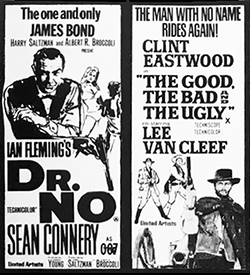 |
|
 |
|
A
new double-bill from United Artists then went on general release
across the UK in early
November 1971. From Russia With Love which had not been seen in
cinemas for two years, was paired with Hang 'Em High, a 1968
Western directed by Ted Post, and also starred Clint Eastwood. This
was not part of the ‘Dollars’ series, but in the eyes of the average
cinemagoer it was from the same stable. The film was made after
Eastwood's return to the USA once the Italian westerns had been
released, and was clearly an attempt to cash-in on their success. The
‘One and Only’ double-bills had more or less finished their life-cycle
by the end of 1971 to make way for Diamonds Are Forever which went
on general release in March 1972, but were revived later in the year
along with a new official United Artists James Bond double-bill which
paired Dr. No with Thunderball. |
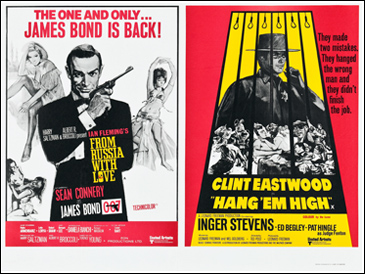 |
|
 |
|
Although Sean Connery had
made it clear he was finished with Bond, he did attend the press show of Diamonds
Are Forever at the ODEON Leicester Square on Wednesday December 29,
1971, bringing Roger Moore as his guest, fuelling speculation that Moore
would be cast as the next 007. Roger Moore was not formally announced as
the new James Bond until August 1, 1972 - and until then Sean Connery
would still reign at the box-office. However, not all of Sean Connery's
films would prove profitable for United Artists. In December 1971 Diamonds
Are Forever had broken box-office records at the ODEON Leicester
Square, but just over a year later The Offence played to a largely empty
auditorium at the flagship 2,000-seat West End cinema. Opening on Thursday
January 11, 1973, The Offence failed to attract a large audience at
the huge venue, and there was a similarly poor reception (even when paired
with the popular 1971 James Garner comedy Western Support Your Local
Gunfighter) at the 1,934-seat New Victoria, where the two films played
for six days from Monday February 5th. The Offence fared better at the
four-screen Cinecenta off Leicester Square in Panton Street, where the
film played on the smaller 150-seat Screen 1 for three weeks from Thursday
February 15, 1973. With its grim subject matter The Offence was far
more suited to intimate art-house cinemas than the vast auditoria of the
large picture palaces. |
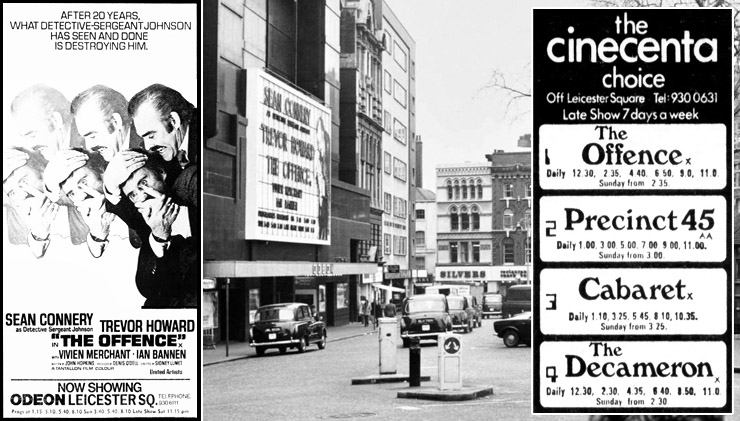 |
|
As part of Sean Connery's
$1.25 million contract to return as 007, United Artists agreed to finance
two other films of his choosing in which he starred or directed. The
Offence was made in association with Connery's own production company Tantallon Films
- a four-man partnership between Connery, his agent Richard Hatton,
British film producer Denis O'Dell, and seven time James Bond associate
producer Stanley Sopel. In spite
of its relatively small £385,000 budget The Offence did not make a
profit for nine years. Although critically acclaimed at the time of its
release, the box-office failure of The Offence caused United
Artists to pull out of the deal they had made with Connery, and a planned
film version of Macbeth (which Connery was to direct) was shelved
after the success of Roman Polanski's 1971 hit. |
|
The Offence had
a brief general release across the UK from Sunday March 11, 1973 and
was then largely unseen until its BBC1 television premiere at 9.25pm
on Monday April 21, 1980. Detective-Sergeant Johnson in The Offence
(1973) is now widely regarded as one of Sean Connery's finest screen
performances.
On Saturday March 17, 1973 The Offence was
playing at the 1,198-seat ODEON Camden Town, but the afternoon
performance was given over to a sell-out live closed-circuit
television screening (in black & white!) of the FA Cup quarter-final
tie between Chelsea and Arsenal. Live football was clearly more
profitable than the depressing Sean Connery drama. With tickets
selling at £1.80 each the live screening grossed over £2,000 for the
cinema. By comparison, the average price of a cinema ticket in 1973
was 40-pence, illustrating just how unpopular The Offence was
on its original release. |
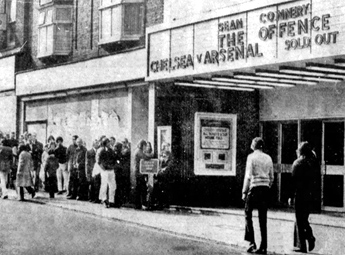 |
|
The Offence
ODEON Camden Town Saturday March 17, 1973 |
|
|
|
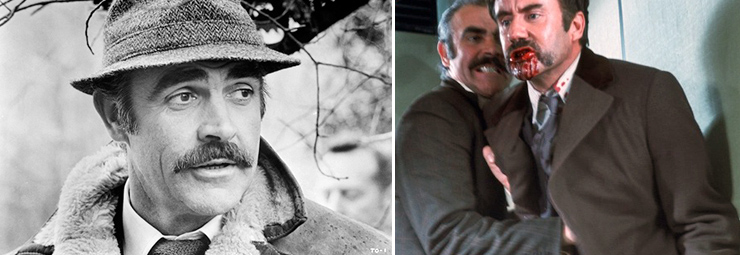 |
|
By the end of the decade
United Artists were suffering financial difficulties, and it would be a
double-bill of two of their biggest hits that temporarily helped save them
from bankruptcy. Roger Moore's third James Bond adventure, The Spy Who
Loved Me, would be paired with a film from United Artists’ other
successful franchise, in an attempt to recoup some of their losses. The
first two Inspector Clouseau films had been major box-office hits for
United Artists, but the series would go on to even greater heights when
Peter Sellers finally agreed to reprise his most famous role in 1975. |
|
 |
 |
|
|
|









